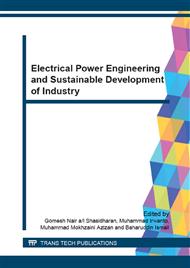p.348
p.353
p.358
p.363
p.368
p.373
p.378
p.383
p.388
Flywheel Energy Storage for Wind Energy System with SEIG-Motor Set
Abstract:
Intermittent wind energy in producing optimal power flow could lead to unstable generated power. Due to this, an energy storage that can release and absorb energy need to be used in order maintains the generated voltage at the permitted quality for the load. Nowadays, tons of energy storage systems are used in storing the energy. Flywheel energy storage system (FESS) becomes one of potential mechanism that can be used to smooth the voltage output of wind turbine due to its advantages. The aim of this study is to design and implement a FESS for critical load in a wind energy system that can store energy for a short time period. Then, period of the voltage generated by FESS using different capacitance is analyzed. FESS consists of a self-excited capacitance induction motor-generator set (SEIG), controller circuit and flywheel rotor. In this study, a three phase asynchronous induction machine is used as a motor-generator due to its simplicity, cheap, robust and less maintenance. The flywheel and SEIG-motor set could store the energy for a short period of time, which can be used to compensate for wind instability. Results show that FESS generates variable powers that compensate short time power to the wind system.
Info:
Periodical:
Pages:
368-372
Citation:
Online since:
September 2015
Price:
Сopyright:
© 2015 Trans Tech Publications Ltd. All Rights Reserved
Share:
Citation:


